
Hassan II Mosque.
[ <<previous | index | next >> ]
10:10
We are in the tour bus, setting off from Casablanca for Rabat, after touring the Hassan II Mosque, the third largest mosque in the world (as we were told).
 Hassan II Mosque. |
I slept well until about 05:00, but M. said she had a restless sleep. We went down to breakfast at 07:00 sharp. I had just yoghurt and corn flakes, and some prunes and dates, avoiding the eggs and bread today. M. tried a different pastry. After eating, we returned to our room and packed, then went down to check out and meet up with the tour group at 08:00. Lahcen herded us onto a minibus with our luggage and then we drove off to the mosque for a public tour. We got there by 08:30, and Lahcen told us to assemble at the front entrance of the mosque by 08:45, giving us a few minutes to walk around and take photos of the outside. The building is stunning from the outside, and visually defies one's sense of proportion. It looks like someone took a normal sized building and just scaled it up about five times. Surrounding it is a large flat courtyard paved with patterned stone, which is used for prayers during special events when the mosque is full inside.
The tour started at 09:00, and we were joined by a few others groups and some individual travellers for an English guided tour led by a woman named Nadia. There were also simultaneous tours starting at the same time in French, German, and possibly one or two other languages. The women in the group put scarves on to cover their heads, and we all took our shoes off and carried them in supplied plastic bags as we entered the mosque. The interior was vast and cathedral like, with intricate marble floors, partly covered with huge carpets in places. The several large tour groups split into clumps by language and dispersed throughout the huge space. Nadia gave a running commentary on the various aspects of the mosque, what various areas were used for, and details of its construction. The giant roof can be opened up to expose the interior to the sky, and channels in the floor can be filled with water, allowing worshippers to be close to three elements: sky, water, and earth. Nadia said that the fourth element, fire, was not used.
 Hassan II Mosque, interior. |
After touring the large ground floor, we went downstairs to the ablution rooms, where worshippers wash before prayers. These had large mushroom shaped fountains made of stone where people could wash, though they were not running at the time. From there we went further down to a chamber which had a hot pool of water in it, making the air very humid and steamy. This was designed for bathing, but Nadia said it hadn't been used yet, because the authorities kept on saying it would be opened for use "next year", but that never seemed to happen.
The tour over, we returned to the bus and our driver started off for Rabat. We've been joined by the last person in our group this morning, a woman named Anna. We also learnt the names of the Canadian women, Karen from Edmonton and Heather from Victoria, and Jay and Jill and Maria from Australia. Lahcen says we will have a stop on the way to Rabat to visit a bank so people can get some cash, and we will have lunch once we arrive there before this afternoon's tour. We were last on the bus this morning, so I am sitting next to Terry and M. is behind me next to Maria, the retired teacher.
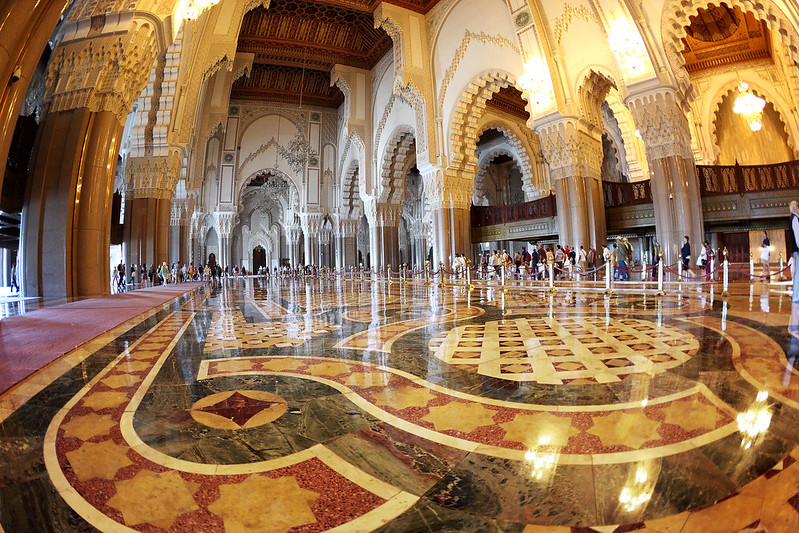 Hassan II Mosque, interior. |
16:10
We are on the bus again and heading out of Rabat to our stop for this evening in Meknes. The afternoon has been full since we arrived in Rabat at about midday.
Our first stop was a bank for people to withdraw or exchange money. This took a little longer than expected because the ATM was being serviced as we arrived and we had to wait for them to finish. I withdrew some dirhams and put together 600 for our contributions to the tour group kitty, from which Lahcen will pay various tips to people we deal with during the tour, to save us all the bother of having to deal with tipping multiple people over the next two weeks. Back on the bus, Lahcen collected the 300 dirhams from everyone, with people passing notes up from the back of the bus. When he counted the total, it was 600 dirhams over what he expected, but nobody claimed to have to put in any extra. As I was at the front of the bus I had strategically taken out some of the 100 dirham notes that passed through and replaced them with 200s in order to have smaller change, but I'm sure I did the substitution correctly. In the end, everyone agreed that Lahcen should just hold on to the extra to cover any additional group expenses.
The next stop was a place called Pizza Capri for lunch. We sat at a long string of tables outside under the arched shade of a verandah area. The menu consisted of pizzas and sandwiches and a few other things. M. got a margherita pizza while I ordered a capricciosa without any idea what would actually be on it. We also ordered a large bottle of water to share, but there was some confusion when the waiter brought out two small bottles (which contained less for more dirhams), and the situation was only rescued by Maria who is somewhat fluent in French. The pizzas were mediocre and a bit bland with lack of saltiness, but filled our stomachs.
After lunch, we were joined by a local guide named Aziz, who took us around Rabat for the afternoon while Lahcen went to enter personal details of the people who had joined our group after the meeting last night. The bus driver took us to three different places in Rabat, and we got out and walked around at each one. But first we drove past the royal palace to have a look at that, but it was in a guarded complex and we didn't get out there.
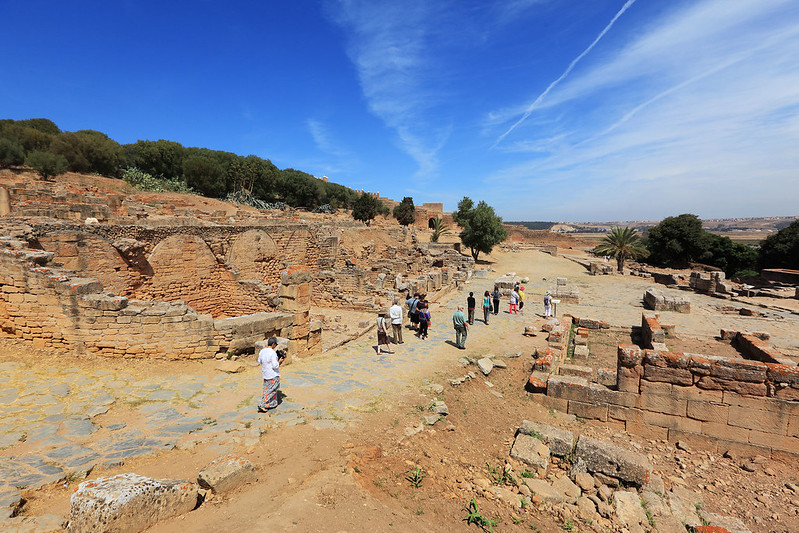 Roman ruins, Chellah, Rabat. |
The first stop was the old fortified settlement and necropolis of Chellah, just outside the walls of the old city of Rabat. This had been converted into a beautiful garden inside, full of different fruit and flowering trees, and was a nice shady place to be out of the sun. Also within the fortifications were some extensive Roman ruins, as the fort had been built on the same site by the side of the river which separates Rabat from the town of Salé on the north shore of the river. Some of the ruins had been reused by Islamic builders to create a mosque and minaret, but these now were also in ruins, and storks have built large nests on top of various parts of the structure, including the minaret. The garden was watered by a natural spring, which was sluiced into channels between the trees. In another spot, the natural water was collected in a pool which used to be used for ablutions before prayer, but now the pool is full of eels. A man by the pool tossed in some boiled egg whites to attract the eels so we could see them, and fed the yolks to a pack of scrawny cats who were wandering around all over the fort.
 Ruins of mosque, Chellah, Rabat. |
The weather in Rabat was a bit cooler than in Casablanca, but walking in the sun still made us quite hot. The next stop was the Mausoleum of Mohammed V, the king of Morocco until, and I asked Lahcen if we would be out in the sun much more. He replied that we would, so M. and I put more sunscreen on our arms. The mausoleum turned out to be a modern part of a complex built on the site of an ancient mosque which had begun construction under the rule of Abu Yusuf Yaqub al-Mansur in the late 12th century, but never been completed. The plan had been to build the tallest minaret in the world, but the minaret stands uncompleted to this day. The main part of the planned mosque had a roof supported by repurposed Ancient Roman columns, but the roof collapsed during the great Lisbon earthquake of 1755, leaving just the columns which now stand in various states of disrepair, punctuating a large open courtyard.
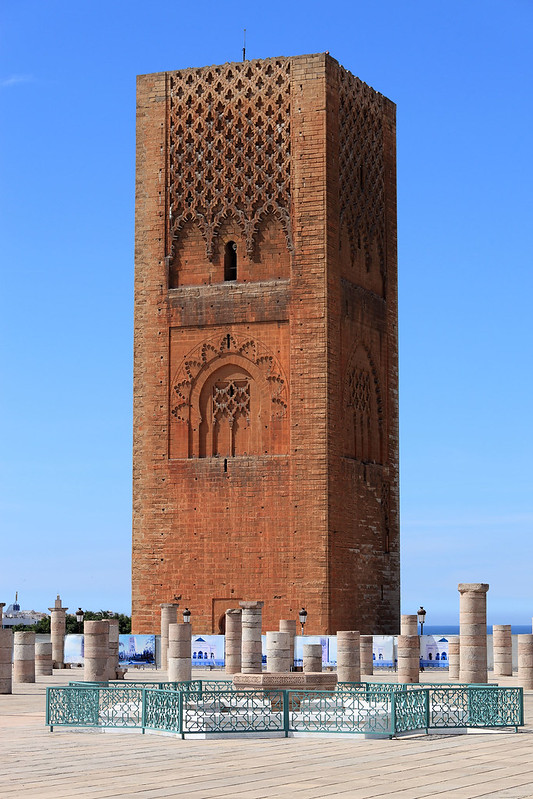 Hassan Tower, Rabat. |
At one corner of the courtyard stands the mausoleum, at the top of a set of marble steps. At the next corner is a structure of arches supporting a roof, which Aziz said was built with the mausoleum solely to provide a sense of symmetry to the courtyard, in a deliberate echo of the Taj Mahal, since the architect was Indian. The mausoleum was guarded by a dozen or so men in ornate uniforms and carrying decorated antique rifles. They merely looked bored as we entered and snapped pictures of the beautiful architecture and decorations.
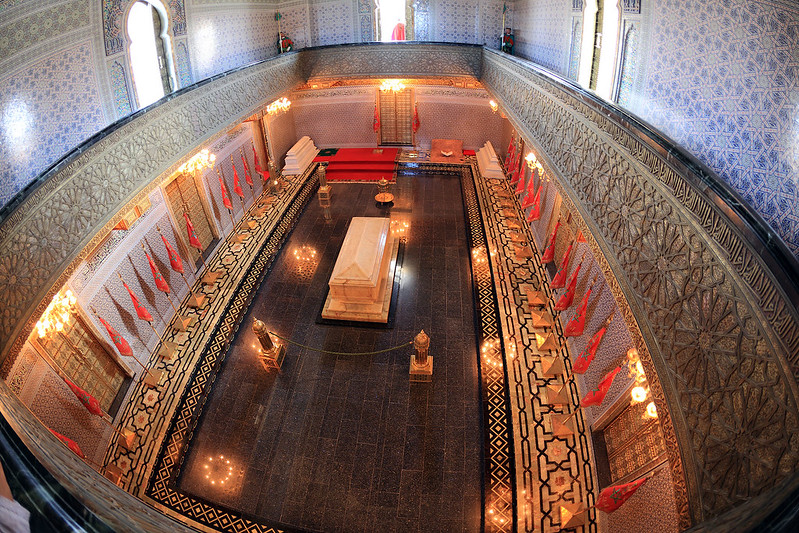 Mausoleum of Mohammed V, Rabat. |
Leaving the mausoleum, the next stop was the Kasbah of the Udayas. Aziz explained that "kasbah" means "fort", and the fort was built on the cliff overlooking the river and the entrance to the ocean, making it a very nice location. The interior of the Kasbah has long since been converted into a rabbit warren of houses, which are painted blue and white in an uncanny resemblance to the Greek Island of Santorini. The view from there was good, but the maze of alleys and the buildings themselves were gorgeous. The Kasbah also held a garden similar to the one at the old fort, but smaller.
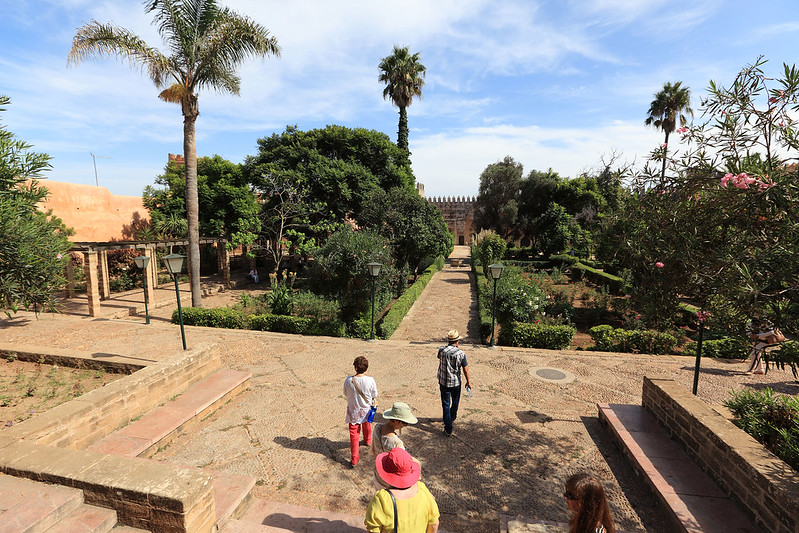 Kasbah of the Udayas, Rabat. |
As we walked through the Kasbah, the group strung out like a series of beads as people stopped to take photos and admire the scenery, but we managed to avoid losing anyone - which is good because the place was a real maze. Just outside the Kasbah was a stepped ramp which had been temporarily fenced off. Aziz explained that the film Mission: Impossible 5 is currently being filmed in Rabat, and some time in the next few days they will be filming a car chase down that ramp. (We later learnt that the car chase scene was filmed with Tom Cruise on 26 September, just 11 days after we were there.)
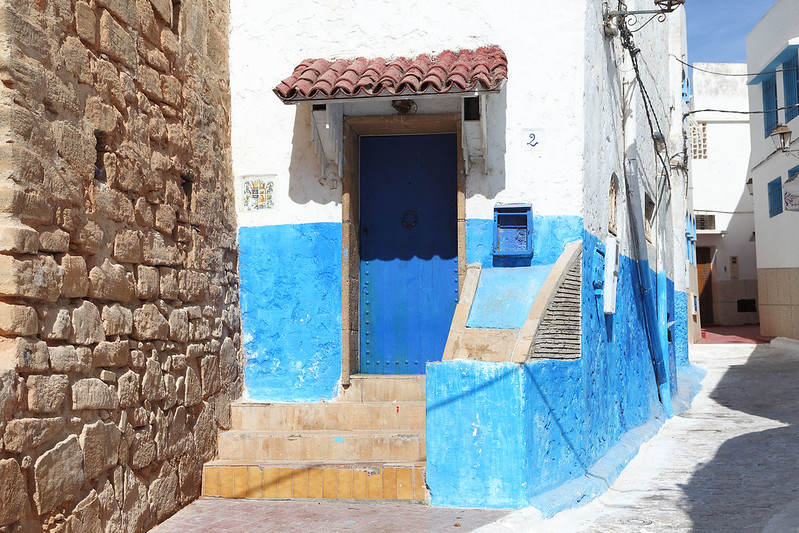 Kasbah of the Udayas, Rabat. |
At the bus, Lahcen met us again and we piled in for the drive to Meknes.
17:40
We have just had a short rest stop in a service station by the side of the freeway. M. and I both used the toilets which were in a separate block near the parking area, a short distance from the cafe and snack shop. Also in the block was a small mosque with several pairs of shoes left outside. The toilets were rather lacking in amenities, with squat toilets, and no wash basins - just some taps in the wall over a drainage trough for washing. M. said there was one western toilet in the ladies side, which she used. After we were done there, we walked into the cafe, only to find there were more toilets in there, and very modern and clean looking ones!
M. grabbed a cherry juice drink which cost 12 dirhams. I tried to pay with a 100 dirham note and the woman indicated she wouldn't accept it. So I tried a 50 and got change for that. After the drink M. decided to get some chocolate as well, so we broke another 50 dirham note for that, which cost 24. So now we should have plenty of small change. In the car park was a smashed up car, parked in front of a billboard with what was obviously a "drive safely" message on it. Very graphic!
Back on the road, we have passed up into some hilly country, and now down a slope into a broad valley full of farmland. The countryside is very yellow and brown, with scattered trees. A lot of the tees are eucalyptus, imported from Australia. There are also lots of prickly pears, olive trees, and Lahcen pointed out a large number of oak trees, from which the bark had been stripped off for cork to make fishing boat parts and life vests. We've seen sheep and cows and horses and donkeys. There are oleanders growing down the centre of the freeway. Ben commented that the landscape looks a bit like what you see driving from Melbourne to Sydney.
22:32. Hotel de Nice, Meknes.
We arrived here in Meknes and checked into our hotel for the night. Lahcen gave us an hour before meeting for dinner at 19:40. He took us a short walk to a restaurant just a block away, which served traditional Moroccan food. The area around the hotel looks like the centre of town, with a lot of shops and people bustling about. In the restaurant were three other tour groups! The place offered a set menu for 77 dirhams, or a la carte choices for entree, mains, and dessert. Everyone else went for the fixed menu, while M. and I chose just mains: tajine aux poulet for me and couscous vegetarien for M. We had a bit of a wait for our food as the others slowly got their entrees, but we had bread and olives to nibble on. Lahcen seemed to get a bit impatient with the restaurant staff, and hurried them up with our meals because we were sitting with nothing while everyone else had an entree. When they arrived, our meals were excellent. The chicken came with carrots, peas, onions, and preserved lemon, and was deliciously spiced. M. said the couscous was spicy and good. It had carrots, zucchini, chick peas, and probably some other stuff, spiced with cinnamon.
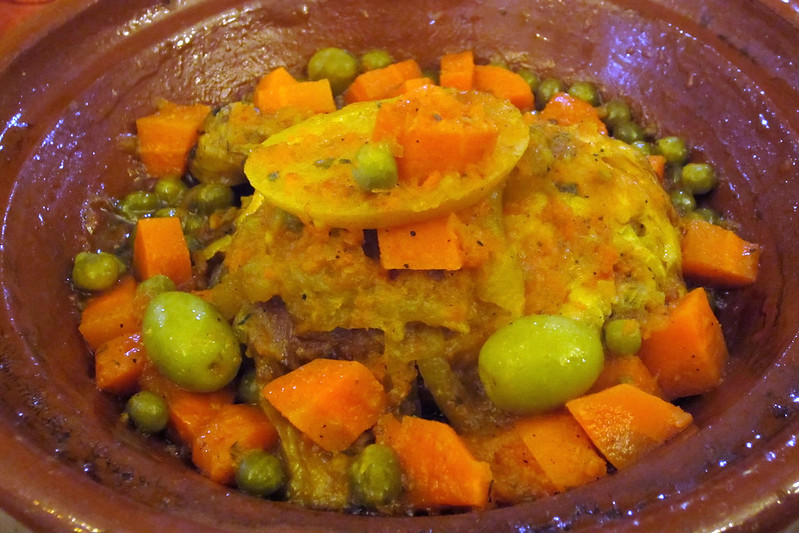 Tajine aux poulet, Meknes. |
With everyone else still waiting for dessert and us tired, we left Lahcen with our share of the bill (130 dirhams including a tip) and came back to our room at about 21:45. The others will be back even later. We showered to wash off the grime of the day and are about to turn in to bed. We start at 09:00 tomorrow for a tour of sights in Meknes before heading on to Fes in the afternoon.
[ <<previous | index | next >> ]